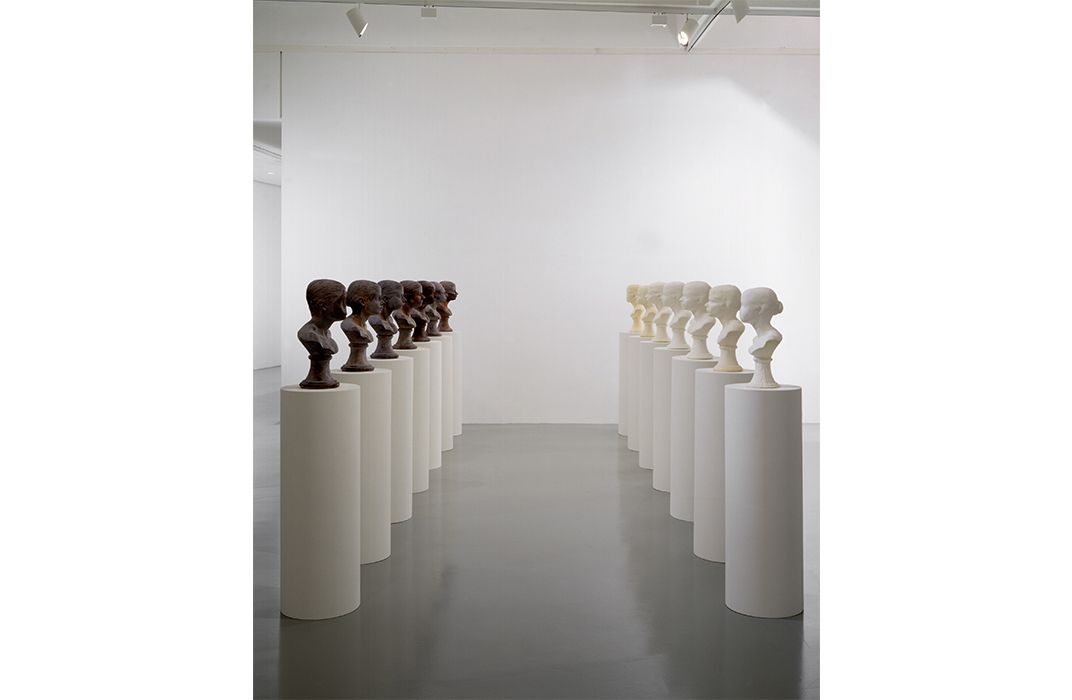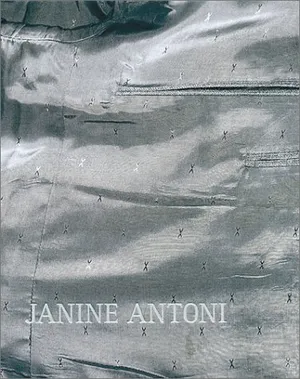The Art of Chocolate (and Soap)
Conservators went on a scientific journey to discover the best ways to preserve artist Janine Antoni’s landmark “Lick and Lather”
:focal(515x234:516x235)/https://tf-cmsv2-smithsonianmag-media.s3.amazonaws.com/filer/72/c6/72c6c553-648c-48d9-8365-4851dbab560b/lick-and-lather-correctedweb.jpg)
It often takes first-time visitors a few minutes to figure out exactly what’s different about the two portrait busts standing next to each other on the third floor of the Hirshhorn gallery. The two busts—one a deep brown, the other a smooth off-white—are sculpted from two of the more uncommon materials in the Hirshhorn collection: chocolate and soap.
Contemporary artist Janine Antoni created the original sculptures in 1993 from molds of her own head. Then she licked the chocolate bust down until its features became indistinct, and took the soap bust into the shower with her, letting water slowly erode its features. Hence the artwork’s name: Lick and Lather. The goal of licking and washing the busts, says Antoni, was to highlight the conflicted, but intimate, relationship that many people have with their surface appearance.
“Both acts [licking and washing] are very gentle, loving, intimate acts, but what was curious to me was that through that act I was erasing myself,” says Antoni, who was born in the Bahamas, but is now based in New York.
For Antoni, the busts provided a new form of intimacy: it was the first time she’d worked with a representational self-portrait, although not the first time she’d used her body as a tool in her artwork. A previous piece, Gnaw, had involved chewing down a large slab of chocolate and another slab of lard, and then using the chewed materials to create new, smaller pieces. She says Lick and Lather represented a natural evolution of the concepts in Gnaw using the body and everyday materials to make the artistic process more transparent and meaningful. Taking the soap bust into the shower with her, she says, was almost like “washing a baby.”
But the busts also offer another commentary. Antoni created the busts to be shown at the Venice Biennale, an international cultural exposition. She says she wanted to create an artwork that would reference that city’s well-known classical artwork, but with a twist. She wore down the soap and chocolate to emphasize the everyday, as opposed to the grandiose. But when she arrived in Venice, she noticed how many classical busts had also aged in unexpected ways.
“I saw these marble sculptures that were washed down very much like the soap heads,” she says. “I think that we think of aging as something that happens to us, something we can’t control. I started to think about the way we live our lives as a reflection on how we choose to age.”
For Hirshhorn curators, the busts represent an unusual and important commentary on the classical tradition. In the newly refurbished third floor galleries, artwork is organized by theme. Lick and Lather stands in the same gallery as paintings of male nudes by artists such as Lucian Freud and Francis Bacon.
“It’s great, in that company, to get a woman’s perspective,” says Hirshhorn curator Melissa Ho. “This [piece] is very much about a female artist’s point of view.”
Ho says that once visitors realize what the materials are, they often try to smell the chocolate bust, as if to confirm that it’s really chocolate. The viewing experience is sensual and intimate, just like Antoni intended.
“With a conventional representational painting, part of the magic is that you don’t understand the process behind it,” Ho says. “By contrast, with Lick and Lather, the magic is exactly that it is very readable.”
Lick and Lather also represents something else—the success of a long and scientific partnership between Antoni and the Hirshhorn’s conservators.
The Hirshhorn acquired its version of the work in 2001. But sometime between 2004 and 2008, the Hirshhorn’s soap bust began to decay. Both the busts had aged, with the chocolate bust taking on the same whitish tinge that a chocolate bar does when it’s been around for a while. To an extent, this normal aging is part of the artwork’s intention, says Antoni. But the soap bust had developed problematic-looking white crystals on its surface, which distracted from the message. Eventually, the changes in the soap bust became prominent enough that curators realized the bust would have to be repaired if the piece were ever to go back on display at the museum.
Hirshhorn conservator Gwynne Ryan suggested calling Antoni to get her input on the process. Although partnerships between artists and conservators are becoming more common in the contemporary art world, they still aren’t the norm, she says.
“In terms of the field of contemporary art conservation we’re learning that this has to be part of our workflow,” says Ryan.
The conservators needed Antoni’s input partly because there isn’t a lot of scholarship about how to preserve soap as an artistic material. Over the past hundreds of years, conservators have built up a wealth of information on how to preserve different artistic materials, even unconventional materials like chocolate. There’s even a book on how to conserve chocolate-based art, says Ryan.
But soap represented a new challenge.

Over the next two years, starting in early 2011, Ryan says, Antoni opened her studio to the conservators. They read Antoni’s notes, tested other Lick and Lather soap busts, and interviewed her soapmaker.
They discovered that Antoni’s soapmaker had used different soap formulations for different busts. There are several versions of Lick and Lather in various collections, and the soap busts had aged differently. Bound by a common goal—to discover which soap would yield the most stable busts—Antoni and the Hirshhorn team began experimenting.
Soap is made up of three principal components: fat, water and lye. The Hirshhorn’s bust had become unstable because there was excess lye in it. So the team decided to formulate 16 different varieties of soap in the conservation lab, which they then cut into samples that they tested in different environmental conditions. One batch became a control group, another batch went to Antoni’s studio. Other batches were exposed to UV light, humidity and other conditions.
Eventually, the team discovered which formulation would be the most stable. Antoni gave them a different soap bust to replace the older one.
“The goal of our work is to be able to see it on display, and that’s really satisfying,” says Ryan. “I think we’ve seen this as a really successful collaboration.” Ryan says further experiments may focus on how heat and mold thickness affect the soap’s durability. This information, says Ryan, could be beneficial not just to Antoni and the Hirshhorn, but to the museum conservation community as a whole.
Despite the sometimes unexpected challenges of conservation, Ho says that these unexpected materials are part of the revolutionary impact that pieces like Lick and Lather can have on audiences.
“I think that’s one of the great accomplishments of modernism, that you could make a work of art out of a common household thing,” says Ho, who traces the tradition back to Picasso’s experiments with collages made with newspapers. “That’s been going on for a hundred years, but it’s still an important and disruptive notion.”
Antoni has recently returned to the mold used to create the Lick and Lather busts. She’s using the mold as part of a new artwork. For her, the process has brought her back into conversation not just with a piece that strongly impacted her career, but also with the physical image of her younger self.
“I have used the mold to create a new scenario around the ideas of birth,” she says. “I’m still in relationship with that image.”
/https://tf-cmsv2-smithsonianmag-media.s3.amazonaws.com/accounts/headshot/anika-gupta-240.jpg)

/https://tf-cmsv2-smithsonianmag-media.s3.amazonaws.com/accounts/headshot/anika-gupta-240.jpg)